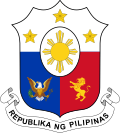1971 Philippine Senate election Last updated June 10, 2025 22nd Philippine senatorial election
1971 Philippine Senate election Majority party Minority party Leader Gil Puyat Gerardo Roxas Party Nacionalista Liberal Seats before 17 (4 up) 6 (3 up) Seats won 3 5 Seats after 16 8 Seat change Popular vote 24,819,175 33,469,677 Percentage 42.56 57.41 Swing
A senatorial election was held on November 8, 1971 in the Philippines . The opposition Liberal Party won five seats in the Philippine Senate while three seats were won by the Nacionalista Party , the administration party; this was seen as a consequence of the Plaza Miranda bombing on August 21, 1971, which wounded all of the Liberal Party's candidates and almost took the lives of John Henry Osmeña and Jovito Salonga . Their terms as senators were cut short as a result of the declaration of martial law by President Ferdinand Marcos on September 23, 1972.
Due to the ratification of a new constitution in 1973, the Senate was abolished and the unicameral parliamentary Batasang Pambansa was instituted. In 1987, a new constitution was approved that reverted to the presidential and bicameral legislative system. This means that this would be the last election for the Senate until the 1987 election .
Electoral system Philippine Senate elections are held via plurality block voting with staggered elections , with the country as an at-large district. The Senate has 24 seats, of which 8 seats are up every 2 years. The eight seats up were last contested in 1965; each voter has eight votes and can vote up to eight names, of which the eight candidates with the most votes winning the election.
Results The Liberal Party won five seats, while the Nacionalista Party won three.
Two Liberal incumbents successfully defended their seats: Genaro Magsaysay and Jovito Salonga , while Alejandro Almendras and Eva Estrada Kalaw of the Nacionalistas successfully defended their seats, as well.
The other four winners are neophyte senators: Eddie Ilarde , Ramon Mitra Jr. , and John Henry Osmeña of the Liberals, and Ernesto Maceda of the Nacionalistas.
Nacionalista Senator Dominador Aytona lost his reelection bid.
1 2 3 4 5 6 7 8 9 10 11 12 13 14 15 16 17 18 19 20 21 22 23 24 Before election ‡ ‡ ‡ ‡ ‡ ‡ ‡ ‡ Election result Not up LP NP Not up After election √ √ * + + * * *
Key:
‡ Seats up + Gained by a party from another party √ Held by the incumbent * Held by the same party with a new senator Per candidate Candidate Party Votes % Jovito Salonga Liberal Party 5,620,272 59.67 Genaro Magsaysay Liberal Party 4,756,376 50.49 John Henry Osmeña Liberal Party 4,668,092 49.56 Eddie Ilarde Liberal Party 4,548,069 48.28 Eva Estrada-Kalaw Nacionalista Party [ a] 4,464,367 47.39 Ramon Mitra Jr. Liberal Party 3,916,833 41.58 Ernesto Maceda Nacionalista Party 3,592,559 38.14 Alejandro Almendras Nacionalista Party 3,427,985 36.39 Manuel Elizalde Nacionalista Party 3,407,276 36.17 Melanio Singson Liberal Party 3,130,332 33.23 Dominador Aytona Nacionalista Party 3,119,995 33.12 Juan Ponce Enrile Nacionalista Party 3,044,461 32.32 Salipada Pendatun Liberal Party 2,885,336 30.63 Blas Ople Nacionalista Party 2,654,067 28.18 Leonila Garcia Nacionalista Party 2,473,684 26.26 Cipriano Primicias Jr. Nacionalista Party 2,099,148 22.28 Total 57,808,852 100.00 Total votes 9,419,568 – Registered voters/turnout 11,661,909 80.77
Per party Party Votes % +/– Seats Up Before Won After +/− Liberal Party 33,469,677 57.42 +16.07 3 6 5 8 +2 Nacionalista Party 24,819,175 42.58 −16.00 4 17 3 16 −1 Nationalist Citizens' Party 1 1 0 0 −1 Total 58,288,852 100.00 – 8 24 8 24 0 Total votes 9,419,568 – Registered voters/turnout 11,661,909 80.77 Source: [ 1] [ 2]
Vote share LP
57.42% NP
42.58%
Senate seats LP
62.50% NP
37.50%
This page is based on this
Wikipedia article Text is available under the
CC BY-SA 4.0 license; additional terms may apply.
Images, videos and audio are available under their respective licenses.



